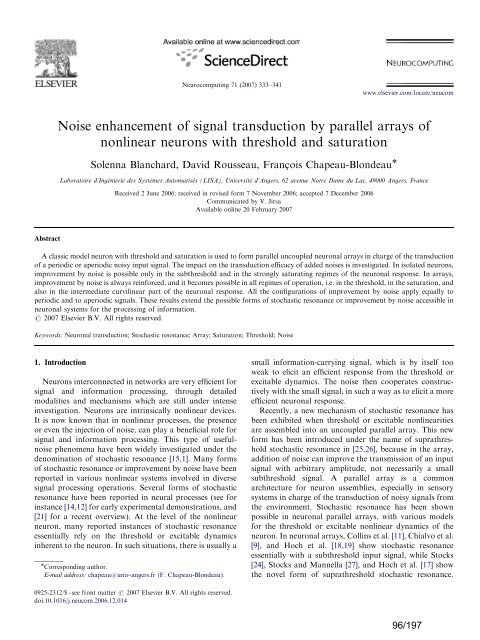a la physique de l'information - Lisa - Université d'Angers
a la physique de l'information - Lisa - Université d'Angers
a la physique de l'information - Lisa - Université d'Angers
Create successful ePaper yourself
Turn your PDF publications into a flip-book with our unique Google optimized e-Paper software.
Abstract<br />
Neurocomputing 71 (2007) 333–341<br />
Noise enhancement of signal transduction by parallel arrays of<br />
nonlinear neurons with threshold and saturation<br />
Solenna B<strong>la</strong>nchard, David Rousseau, Franc-ois Chapeau-Blon<strong>de</strong>au<br />
Laboratoire d’Ingénierie <strong>de</strong>s Systèmes Automatisés (LISA), <strong>Université</strong> d’Angers, 62 avenue Notre Dame du Lac, 49000 Angers, France<br />
Received 2 June 2006; received in revised form 7 November 2006; accepted 7 December 2006<br />
Communicated by V. Jirsa<br />
Avai<strong>la</strong>ble online 20 February 2007<br />
A c<strong>la</strong>ssic mo<strong>de</strong>l neuron with threshold and saturation is used to form parallel uncoupled neuronal arrays in charge of the transduction<br />
of a periodic or aperiodic noisy input signal. The impact on the transduction efficacy of ad<strong>de</strong>d noises is investigated. In iso<strong>la</strong>ted neurons,<br />
improvement by noise is possible only in the subthreshold and in the strongly saturating regimes of the neuronal response. In arrays,<br />
improvement by noise is always reinforced, and it becomes possible in all regimes of operation, i.e. in the threshold, in the saturation, and<br />
also in the intermediate curvilinear part of the neuronal response. All the configurations of improvement by noise apply equally to<br />
periodic and to aperiodic signals. These results extend the possible forms of stochastic resonance or improvement by noise accessible in<br />
neuronal systems for the processing of information.<br />
r 2007 Elsevier B.V. All rights reserved.<br />
Keywords: Neuronal transduction; Stochastic resonance; Array; Saturation; Threshold; Noise<br />
1. Introduction<br />
Neurons interconnected in networks are very efficient for<br />
signal and information processing, through <strong>de</strong>tailed<br />
modalities and mechanisms which are still un<strong>de</strong>r intense<br />
investigation. Neurons are intrinsically nonlinear <strong>de</strong>vices.<br />
It is now known that in nonlinear processes, the presence<br />
or even the injection of noise, can p<strong>la</strong>y a beneficial role for<br />
signal and information processing. This type of usefulnoise<br />
phenomena have been wi<strong>de</strong>ly investigated un<strong>de</strong>r the<br />
<strong>de</strong>nomination of stochastic resonance [15,1]. Many forms<br />
of stochastic resonance or improvement by noise have been<br />
reported in various nonlinear systems involved in diverse<br />
signal processing operations. Several forms of stochastic<br />
resonance have been reported in neural processes (see for<br />
instance [14,12] for early experimental <strong>de</strong>monstrations, and<br />
[21] for a recent overview). At the level of the nonlinear<br />
neuron, many reported instances of stochastic resonance<br />
essentially rely on the threshold or excitable dynamics<br />
inherent to the neuron. In such situations, there is usually a<br />
Corresponding author.<br />
E-mail address: chapeau@univ-angers.fr (F. Chapeau-Blon<strong>de</strong>au).<br />
0925-2312/$ - see front matter r 2007 Elsevier B.V. All rights reserved.<br />
doi:10.1016/j.neucom.2006.12.014<br />
ARTICLE IN PRESS<br />
www.elsevier.com/locate/neucom<br />
small information-carrying signal, which is by itself too<br />
weak to elicit an efficient response from the threshold or<br />
excitable dynamics. The noise then cooperates constructively<br />
with the small signal, in such a way as to elicit a more<br />
efficient neuronal response.<br />
Recently, a new mechanism of stochastic resonance has<br />
been exhibited when threshold or excitable nonlinearities<br />
are assembled into an uncoupled parallel array. This new<br />
form has been introduced un<strong>de</strong>r the name of suprathreshold<br />
stochastic resonance in [25,26], because in the array,<br />
addition of noise can improve the transmission of an input<br />
signal with arbitrary amplitu<strong>de</strong>, not necessarily a small<br />
subthreshold signal. A parallel array is a common<br />
architecture for neuron assemblies, especially in sensory<br />
systems in charge of the transduction of noisy signals from<br />
the environment. Stochastic resonance has been shown<br />
possible in neuronal parallel arrays, with various mo<strong>de</strong>ls<br />
for the threshold or excitable nonlinear dynamics of the<br />
neuron. In neuronal arrays, Collins et al. [11], Chialvo et al.<br />
[9], and Hoch et al. [18,19] show stochastic resonance<br />
essentially with a subthreshold input signal, while Stocks<br />
[24], Stocks and Mannel<strong>la</strong> [27], and Hoch et al. [17] show<br />
the novel form of suprathreshold stochastic resonance.<br />
96/197


